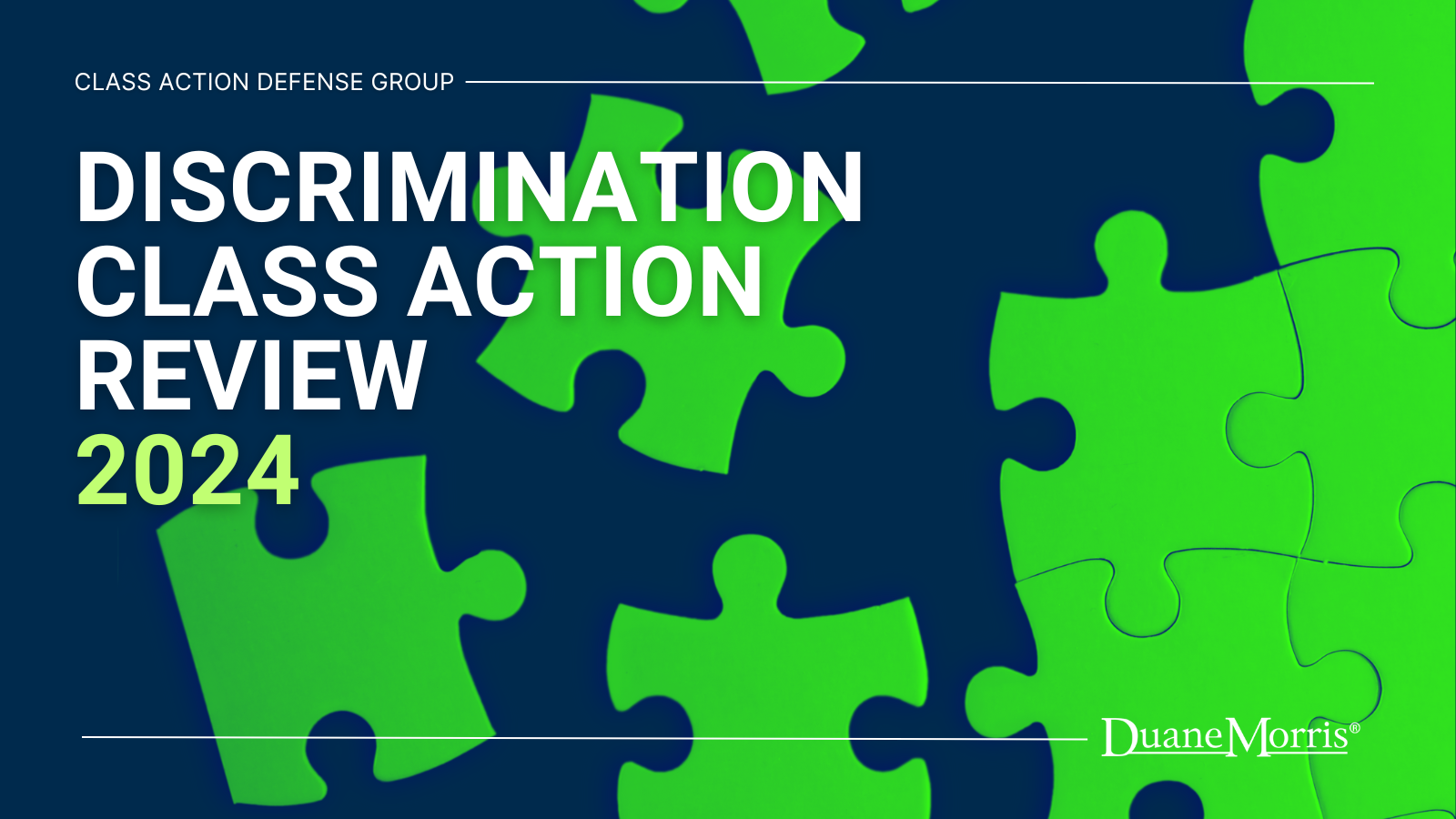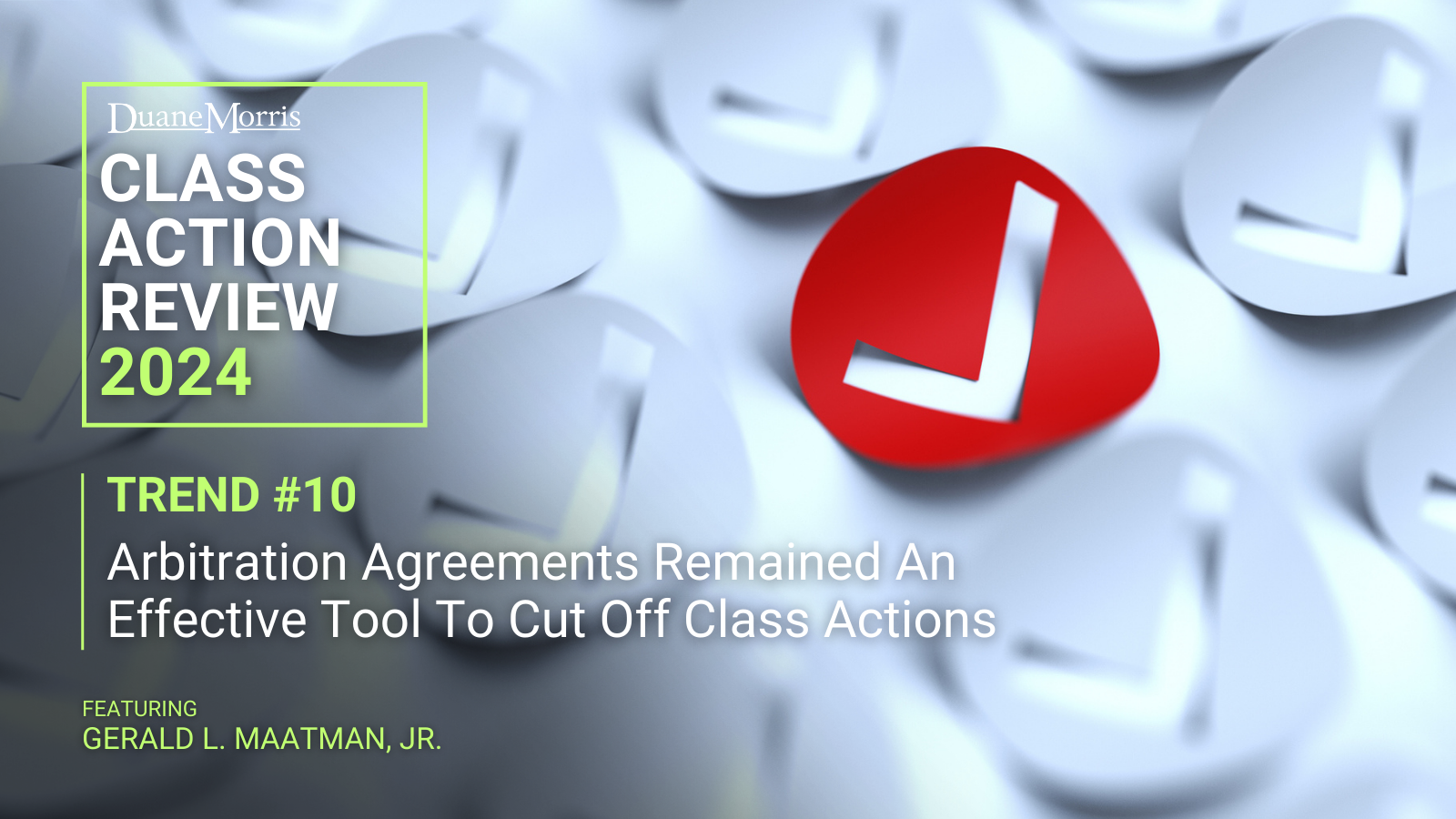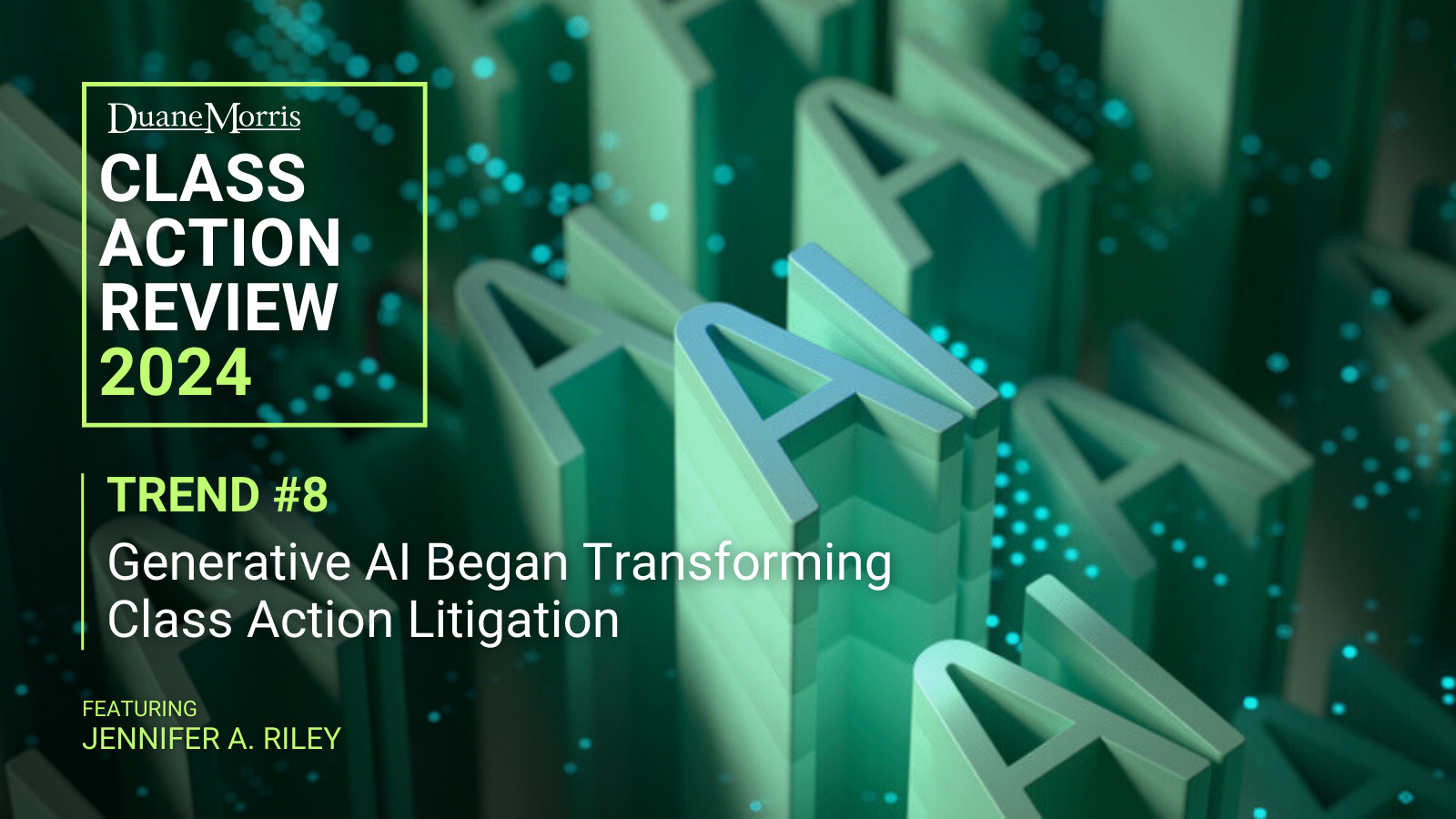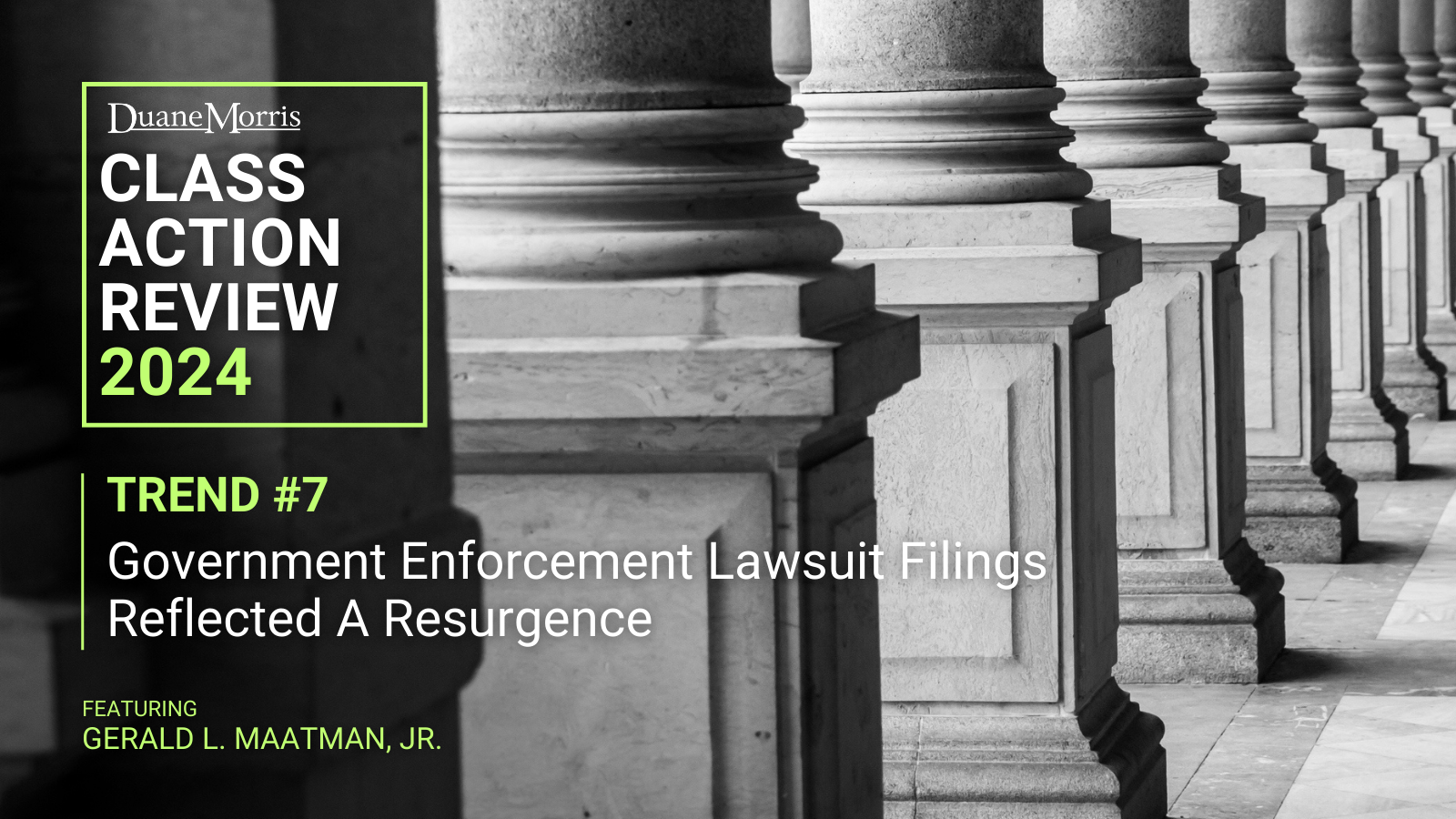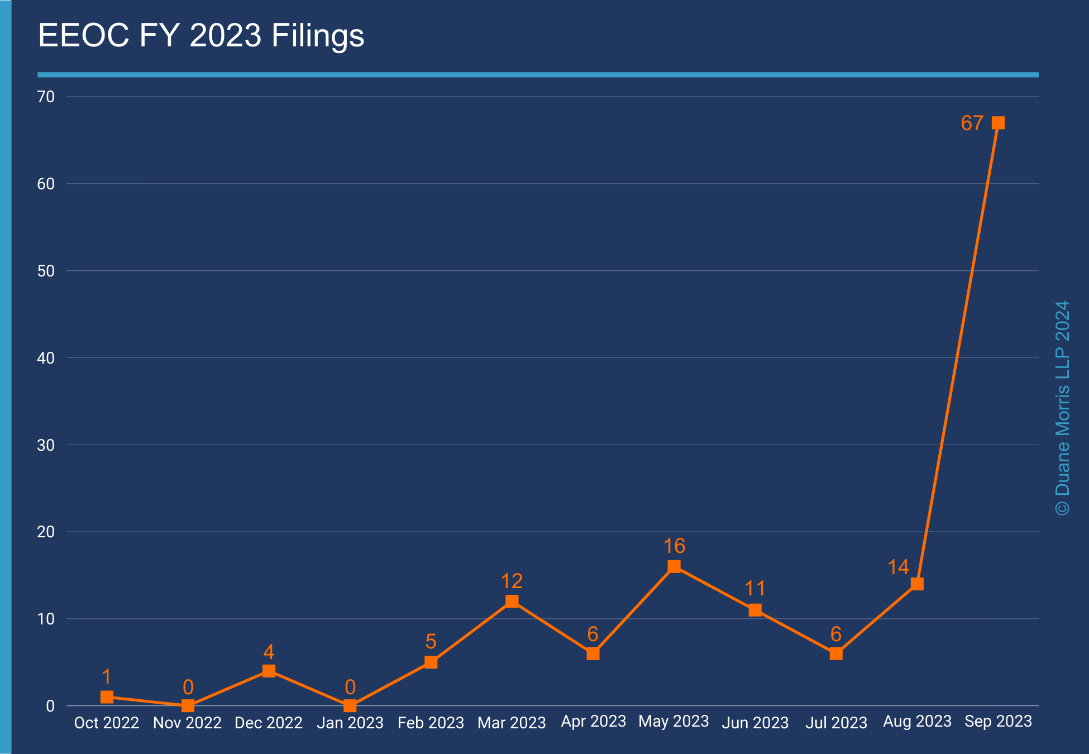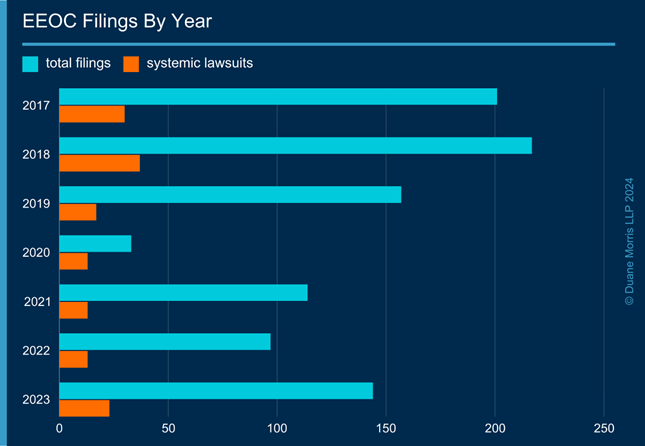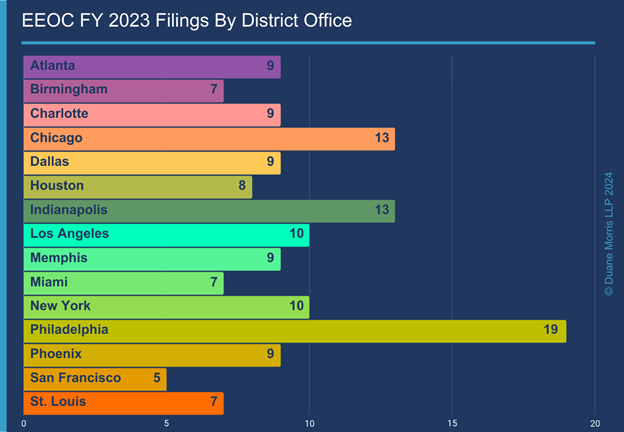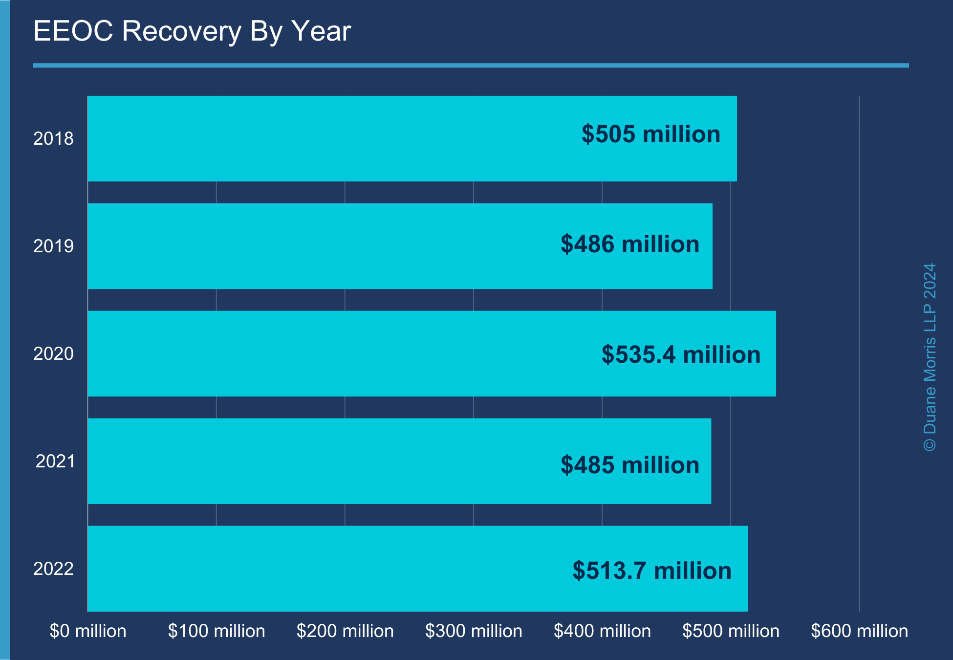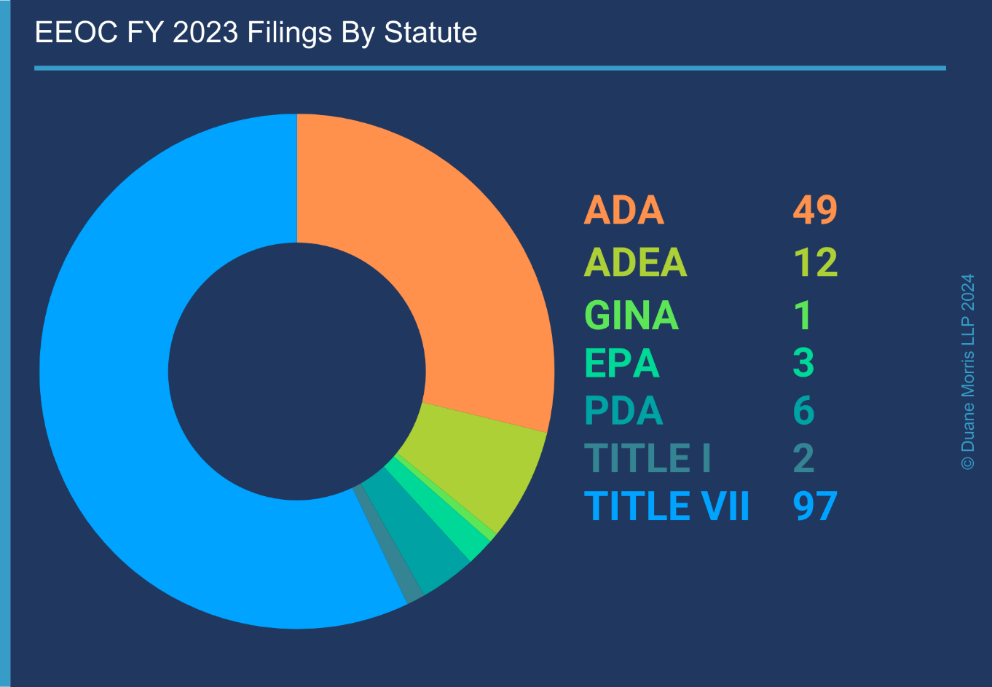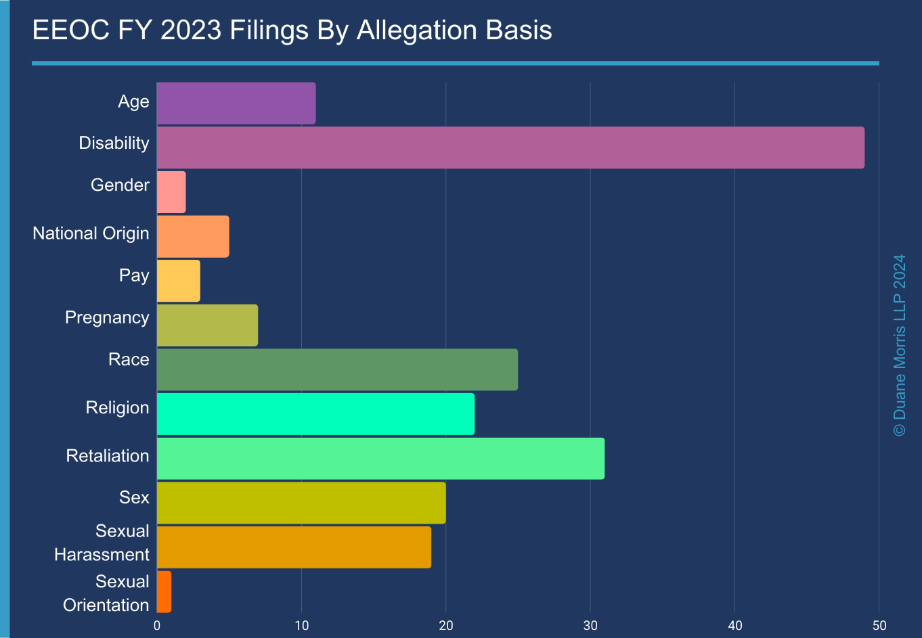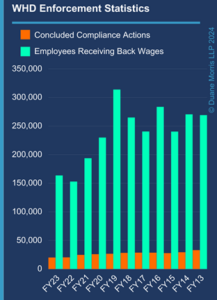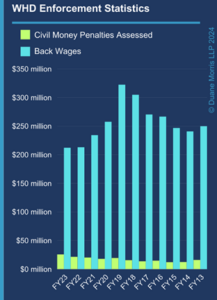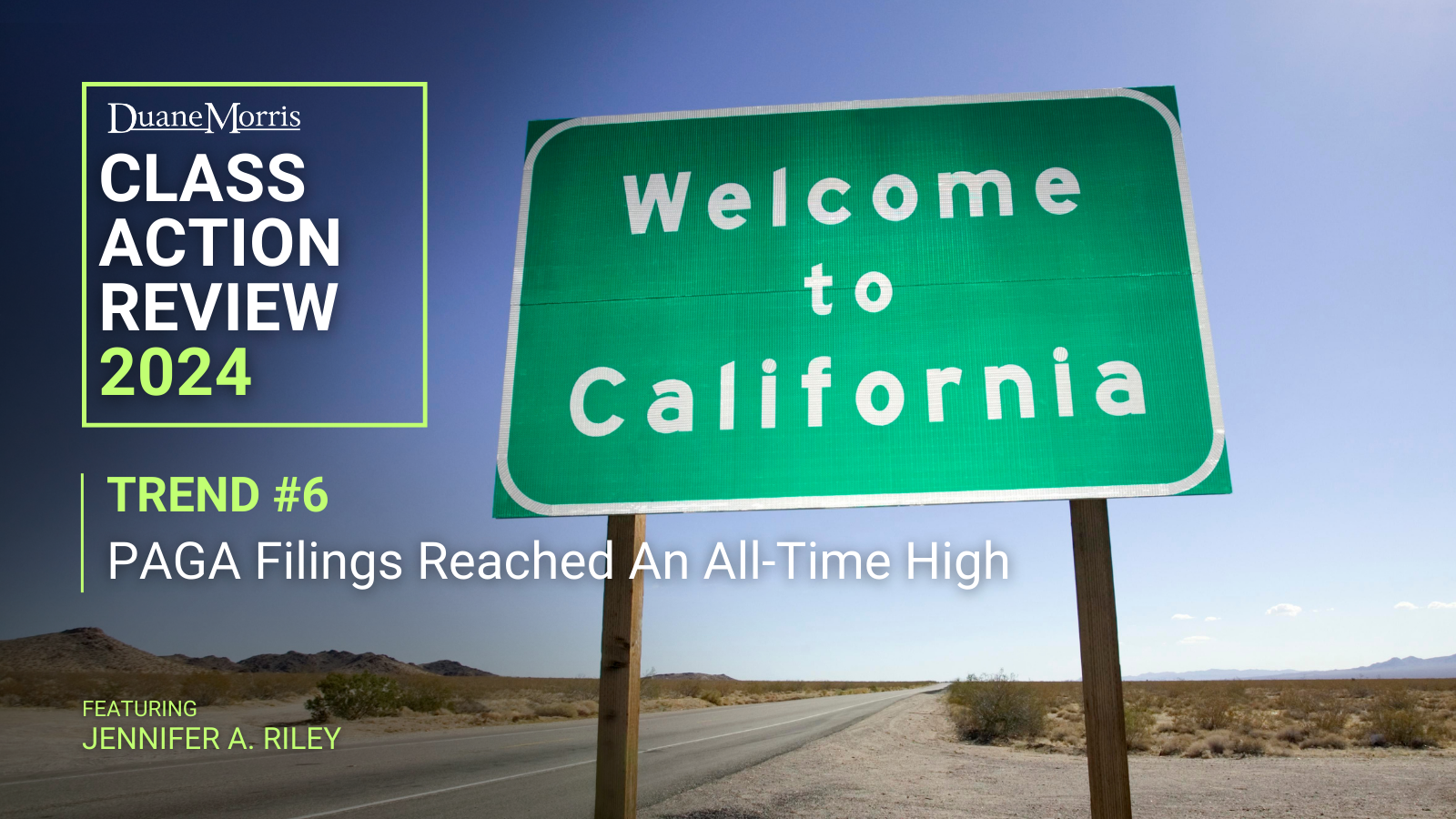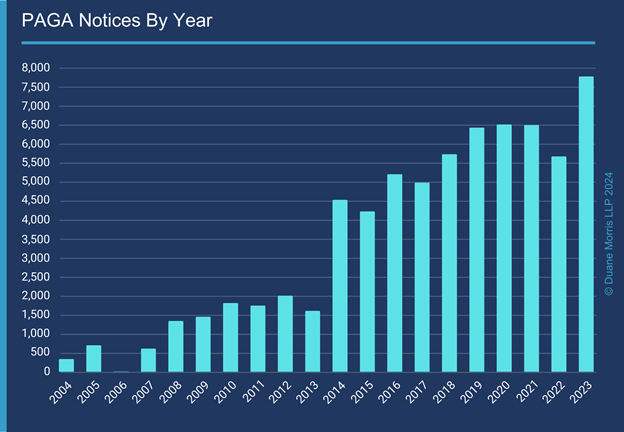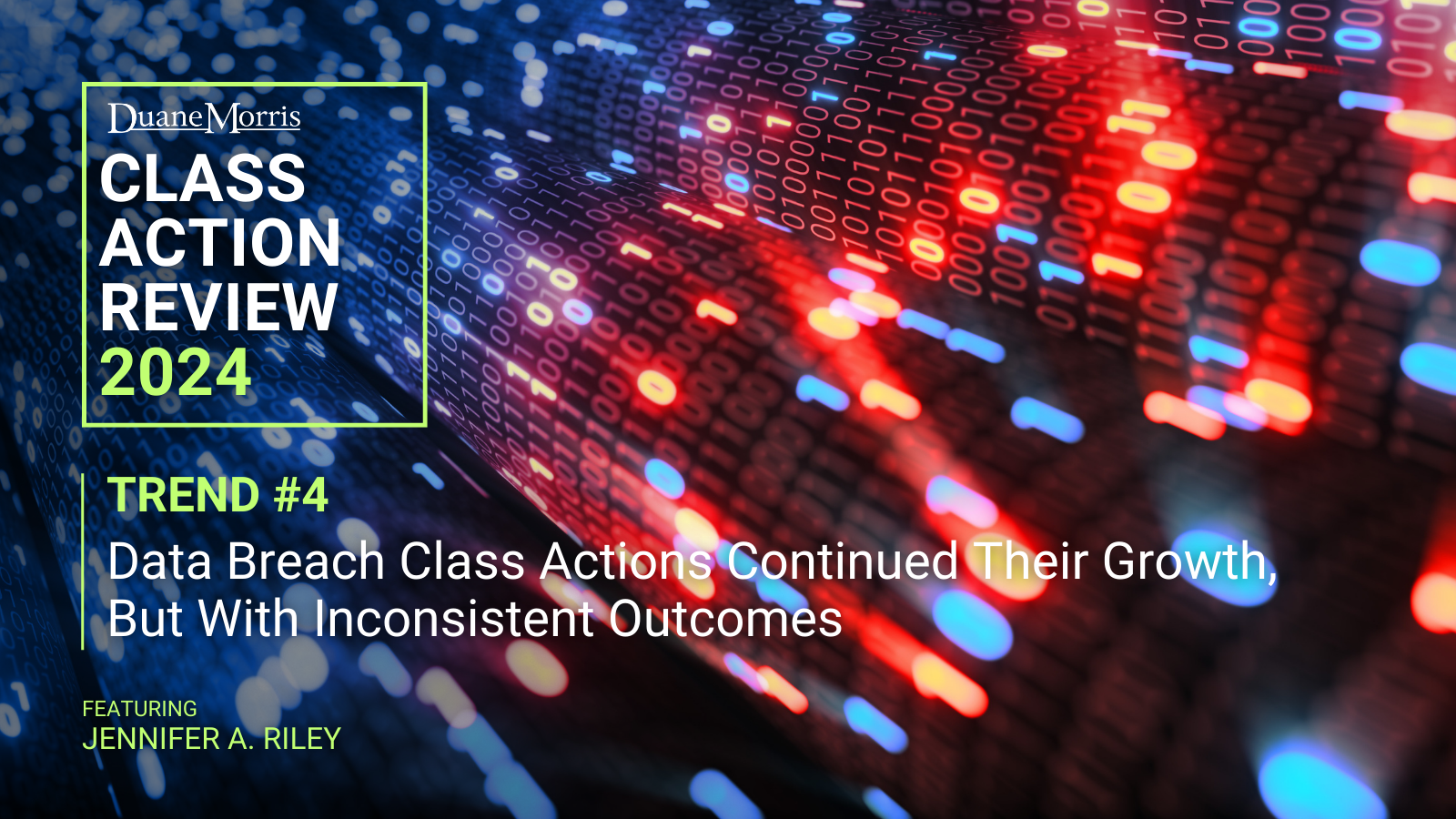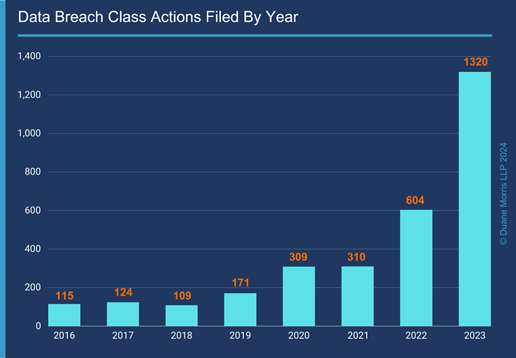
By Gerald L. Maatman, Jr. and Jennifer A. Riley
Duane Morris Takeaways: Corporate defendants saw unprecedented settlement numbers across all areas of class action litigation in 2022, 2023, and 2024, and halfway through 2025, settlement numbers remain robust. The cumulative value of the top ten settlements across all substantive areas of class action litigation hit near record highs in 2024, following the highest levels ever in 2022, and the second highest total in 2023. When the numbers for 2022, 2023, and 2024 are combined, the total signals that corporate defendants have entered a new era of heightened risks and higher stakes in the valuation of class actions.
On an aggregate basis, across all areas of litigation, class actions and government enforcement lawsuits garnered more than $42 billion in 2024, $51.4 billion in settlements in 2023, and a record-setting $66 billion in 2022. When combined, the three-year settlement total eclipses any other three-year period in the history of American jurisprudence.
As a prelude to the Duane Morris Class Action Review – 2026, this blog post reports on our analysis of class action settlements through the first half of 2025. The data shows that for the period of January 1 to June 30, 2025, the current year is on pace with the numbers of the previous three years. As of the end of the first half of 2025, the aggregate settlement total across all areas of class action litigation and government enforcement lawsuits is $21.77 billion (in accounting for the top 5 settlements in the various substantive areas of law). By comparision, in 2024 at the half-way mark, the aggregate settlement total was $22.5 billion.
It is anticipated that these numbers will increase across the board by the end of the year and when measured by the top 10 settlements in each category.
More Billion Dollar Class Action Settlements
At the mid-way point of 2025, there are three settlements over the billion-dollar mark. The 10 individual billion-dollar settlements in 2024 surpassed the number in 2023, and only fell short of the number of billion-dollar settlements in 2022. In 2023, parties resolved nine class actions for $1 billion or more. In 2022, parties resolved 15 class actions for $1 billion or more in settlement dollars. Together with the three thus far in 2025, corporations have seen 37 settlements of one billion dollars or more in three and a half years. This string of settlements marks the most extensive set of billion-dollar class action settlements in the history of the American court system.

Class action settlements totaled $66 billion in 2022, $51.4 billion in 2023, $42 billion in 2024, and $21.77 billion in 2025 so far.
The Scorecard On Leading Class Actions Settlements Halfway Through 2025
The plaintiffs’ class action bar has scored rich settlements thus far in 2025 in virtually every area of class action litigation.

The top 5 class action settlement totals in each practice area. [Click to enlarge]
The following list shows the totals of the top 5 settlements at the mid-year point in 2025 in key areas of class action litigation:
$13.09 Billion – Products liability/mass tort class actions
$4.36 Billion – Antitrust class actions
$2.03 Billion – Securities fraud class actions
$712 Million – Consumer fraud class actions
$300.8 Million – Data breach class actions
$293.75 Million – Privacy class actions
$279.7 Million – Civil rights class actions
$222 Million – Discrimination class actions
$178 Million – ERISA class actions
$86.9 Million – Wage & hour class and collective actions
$77.05 Million – Government enforcement actions
$54.5 Million – Fair Credit Reporting Act class actions
$54.4 Million – Labor class actions
$34.77 Million – TCPA class actions
The high dollar settlements of the past three years suggested that the plaintiffs’ bar would continue to be equally, if not more aggressive, with their case filings and settlement positions. From the 2025 data, it certainly looks to be the case as we end the first half of the year.
The data points in each category are set out in the following charts.
Top Class & Collective Action Litigation Settlements In 2025
Top Antitrust Class Action Settlements In 2025

The top 10 antitrust class action settlements totaled $8.412 billion in 2024, $11.74 billion in 2023, and $3.72 billion in 2022.
- $2.78 billion – In Re College Athlete NIL Litigation, Case No. 20-CV-3919 (N.D. Cal. June 6, 2025) (final settlement approval granted in a class action requiring the NCAA and its Power Five conference members to pay approximately $2.8 billion in damages, characterized as “back pay,” to compensate student-athletes for the denial of name, image, and likeness (NIL) opportunities under prior NCAA eligibility rules).
- $630 million – Loop LLC, et al. v. CDK Global LLC, Case No. 24-CV-571 (W.D. Wis. June 10, 2025) (preliminary settlement approval sought in a class action to resolve claims by automotive technology vendors who alleged the company colluded with Reynolds & Reynolds Co. to inflate prices for data integration services).
- $398 million – Jien, et al. v. Perdue Farms Inc., Case No. 19-CV-2521 (D. Md. June 5, 2025) (final settlement approval granted in a class action to resolve claims by workers alleging the poultry firms violated the Sherman Act by conspiring to drive down their hourly wages and salaries at poultry processing operations).
- $375 million – Le, et al. v. Zuffa LLC, Case No. 15-CV-1045 and Johnson, et al. v. Zuffa LLC, Case No. 21-CV-1189 (D. Nev. Feb. 6, 2025) (final settlement approval granted to resolve claims in a more than a decade-long class action in which fighters accused UFC of suppressing their wages).
- $275 million – In Re Generic Pharmaceuticals Pricing Antitrust Litigation, Case No. 16-MD-2724 (E.D. Penn. Feb. 19, 2025) (preliminary settlement approval granted in a class action to resolve claims brought by consumers, insurers and other end payer plaintiffs alleging that drugmaker Sandoz conspired with other companies to fix the price of certain generic drugs).
Top Civil Rights Class Action Settlements In 2024

The top 10 civil rights class action settlements totaled $313.8 million in 2024, $643.15 million in 2023, and $1.31 billion in 2022.
- $140 million – Nnebe, et al. v. Daus, Case No. 06 Civ. 4991 (S.D.N.Y. May 7, 2025) (preliminary settlement approval granted in a class action to resolve claims from over 19,000 taxi drivers challenging the city’s practice of suspending the license of any driver who was arrested for a felony or misdemeanor).
- $92.5 million – Onadia, et al. v. City Of New York, Case No. 300940/2010 (N.Y. Oct. 6, 2025) (final settlement approval hearing scheduled in a class action to resolve claims by individuals who were unlawfully detained by the NYC Department of Correction).
- $28 million – Doe, et al. v. Johnson City, Case No. 23-CV-71 (E.D. Tenn. May 5, 2025) (preliminary settlement approval sought in a class action to resolve claims alleging that Johnson City businessman Sean Williams drugged and raped more than 50 women in his downtown condo in incidents he captured on video).
- $17 million – Allen, et al. v. Global Tel*Link Corporation d/b/a ViaPath Technologies, Case No. 24-CV-827 (E.D. Va. Feb. 21, 2025) (preliminary settlement approval granted in a class action to resolve claims alleging that the company charged incarcerated individuals and their families excessive fees for communications services).
- $2.2 million – Vigil, et al. v. 2801 Fifteenth Street NW LLC, Case No. 2022 CA 001459 (D.C. Super. Ct. Mar. 27, 2025) (final settlement approval granted in a class action to resolve claims alleging that the apartment complex charged illegal fees and failed to provide habitable living conditions for tenants).
Top Consumer Fraud Class Action Settlements In 2025

The top 10 consumer fraud class action settlements totaled $2.44 billion in 2024, $3.29 billion in 2023, and $8.596 billion in 2022.
- $425 million – In Re Capital One 360 Savings Account Interest Rate Litigation, Case No. 24-MD-3111 (E.D. Va. June 16, 2025) (preliminary settlement approval granted in a class action to resolve claims alleging that the company deceptively advertised its 360 Savings accounts as high-interest savings products).
- $145 million – In Re Xyrem (Sodium Oxybate) Antitrust Litigation, Case No. 20-MD-2966 (N.D. Cal. May 16, 2025) (preliminary settlement approval granted in a class action to resolve claims by direct and indirect Xyrem purchasers, alleging that the company’s actions leading up to, and entering into, patent litigation settlement agreements with generic drug manufacturers who had filed abbreviated new drug applications violated U.S. state and federal antitrust, consumer protection and unfair competition laws).
- $100 million – Cabrera, et al. v. Google LLC, Case No. 11-CV-1263 (N.D. Cal. Apr. 16, 2025) (preliminary settlement approval granted in a class action to resolve claims from advertisers alleging the defendant overcharged for advertisements through its AdWords service).
- $25 million – Anderson, et al. v. Boyne USA, Inc., Case No. 21-CV-95 (D. Mont. June 25, 2025) (final settlement approval granted in a class action to resolve claims from condo property owners alleging that the exclusive rental management requirement of condominium-hotel units violated state and federal law).
- $20 million – Smith, et al. v. Apple, Inc., Case No. 21-CV-9527 (N.D. Cal. May 1, 2025) (final settlement approval granted in a class action to resolve claims alleging a battery swelling defect with early-model Apple Watches in some cases caused watch screens to detach or shatter).
Top Data Breach Class Action Settlements In 2025

The top 10 data breach class action settlements totaled $593.2 million in 2024, $515.75 million in 2023, and $719.21 million in 2022.
- $177 million – In Re AT&T Inc. Customer Data Security Breach Litigation, Case No. 24-CV-757 (N.D. Tex. June 20, 2025) (preliminary settlement approval granted in a class action to resolve claims alleging that the defendant released customer information on the dark web).
- $45 million – In Re MGM Resorts International Data Breach Litigation, Case No. 20-CV-376 (D. Nev. June 18, 2025) (final settlement approval granted in a class action to resolve claims alleging that MGM failed to protect 37 million customers’ personal information from multiple data breaches in and 2023).
- $32.8 million – Baker, et al. v. ParkMobile, LLC, Case No. 21-CV-2182 (N.D. Ga. Mar. 13, 2025) (final settlement approval granted in a class action to resolve claims alleging that the company harmed consumers by failing to secure their data and therefore exposed them to identity theft, fraud, and the need to spend time securing related accounts).
- $25 million – In Re LoanDepot Data Breach Litigation, Case No. 24-CV-136 (C.D. Cal. Jan. 13, 2025) (preliminary settlement approval granted in a class action to resolve claims alleging that the company negligently failed to protect the personal information of nearly 17 million people).
- $21 million – In Re Arthur J. Gallagher Data Breach Litigation, Case No. 22-CV-137 (N.D. Ill. Feb. 27, 2025) (final settlement approval granted in a class action to resolve claims the company failed to prevent a 2020 data breach that compromised sensitive employee and client information).
Top Discrimination Class Action Settlements In 2025

The top 10 discrimination class action settlements totaled $356.8 million in 2024, $762.2 million in 2023, and $597 million in 2022
- $70 million – Ferris, et al. v. Wynn Resorts Ltd., Case No. 18-CV-479 (D. Nev. Feb. 3, 2025) (final settlement approval granted to resolve claims in a class action alleging sexual misconduct allegations against founder Steve Wynn).
- $50 million – Curley, et al. v. Google LLC, Case No. 22-CV-1735 (N.D. Cal. May 8, 2025) (preliminary settlement approval sought in a class action to resolve claims alleging that the company discriminated against Black employees).
- $43 million – Rasmussen, et al. v. The Walt Disney Co., Case No. 19-STCV-10974 (Cal. Super. Ct. May 13, 2025) (preliminary settlement approval granted in a class action to resolve claims alleging that the defendant systematically paid female employees in California less than men for substantially similar jobs; regularly passed women over for promotion; and loaded them with extra work without providing additional pay).
- $31 million – In Re Norwich Roman Catholic Diocesan Corp., Case No. 21-BK-20687 (D. Conn. Feb. 14, 2025) (settlement entered following Norwich Diocese filing for bankruptcy in July 2021 following lawsuits by survivors of clergy abuse at its Academy at Mount Saint John boarding school).
- $28 million – Cantu, et al. v. Google LLC, Case No. 21-CV-392049 (Cal. Super. Ct. Mar. 11, 2025) (preliminary settlement approval granted in a class action to resolve claims alleging that workers identifying as Latino, Native American, and other ethnicities were paid less than white, Asian, and Asian American employees for substantially similar work).
Top EEOC / Government Enforcement Class Action Settlements In 2025

The top 10 EEOC / government enforcement class action settlements totaled $335.9 million in 2024, $263.58 million in 2023, and $404.5 million in 2022
- $20.25 million – U.S. Department Of Labor v. UMR, Inc., Case No. 23-CV-513 (W.D. Wis. Mar. 19, 2025) (consent order entered in an enforcement action that challenged adverse benefit determinations regarding hospital emergency services claims and urinary drug screening claims).
- $20 million – Federal Trade Commission v. Cognosphere LLC, Case No. 25-CV-447 (C.D. Cal. Jan. 17, 2025) (consent order entered in an enforcement action to resolve claims against a video game maker by the FTC alleged that the company misled children and other users about the actual costs of purchases and illegally collected children’s personal information).
- $16.8 million – In The Matter Of The Investigation Of Letitia James, Attorney General Of The State Of New York Of DoorDash Inc., No. 25-007 (N.Y. Feb. 24, 2025) (assurance order effective following an investigation by the Attorney General for New York that found the company cheated about 63,000 food delivery workers out of their full tips in order to subsidize their pay).
- $15 million – U.S. Department Of Labor v. Americare Healthcare Services, LLC, Case No. 21-CV-5076 (S.D. Ohio Jan. 9, 2025) (consent order entered in an enforcement action to resolve claims alleging that the third-party home care agency failed to pay employees overtime compensation).
- $5 million – In The Matter Of The National Women’s Soccer League, No. 25-002 (N.Y. Feb. 1, 2025) (assurance order effective following an investigation by the attorneys general for New York, Illinois, and the District of Columbia found that the NWSL was “permeated by a culture of inappropriate and abusive behavior, including sexual harassment and harassment and discrimination based upon gender, race, and sexual orientation”).
Top ERISA Class Action Settlements In 2025

The top 10 ERISA class action settlements totaled $413.3 million in 2024, $580.5 million in 2023, and $399.6 million in 2022.
- $69 million – Snyder, et al. v. UnitedHealth Group, Inc., Case No. 21-CV-1049 (D. Minn. June 12, 2025) (final settlement approval granted in a class action to resolve claims alleging that the defendant engaged in imprudence, disloyalty, prohibited transactions and failure to monitor in violation of the ERISA).
- $60 million – In Re AME Church Employee Retirement Fund Litigation, Case No. 22-MD-3035 (W.D. Tenn. Mar. 24, 2025) (preliminary settlement approval granted in a class action to resolve claims that the church plan was mismanaged leading to participants losing significant money from the plan in violation of the ERISA).
- $20.5 million – Baker, et al. v. Save Mart Supermarkets, Case No. 22-CV-4645 (N.D. Cal. June 11, 2025) (preliminary settlement approval granted in a class action alleging that the defendant failed to honor its promise to provide them with lifetime retiree medical benefits).
- $14.5 million – Burnett, et al. v. Prudent Fiduciary Services, LLC, Case No. 22-CV-270 (D. Del. Jan. 14, 2025) (final settlement approval granted in a pair of class actions to resolve claims alleging that the resolving claims pilots were forced to overpay for their stake in the company through its employee stock ownership plan).
- $14 million – Coleman, et al. v. Brozen, Case No. 20-CV-1358 (N.D. Tex. Jan. 30, 2025) (preliminary settlement approval granted in a class action brought by participants in All My Sons Moving & Storage’s employee stock ownership plan that when the plan was terminated they received losses).
Top FCRA, FDPCA, And FACTA Class Action Settlements In 2025

The top 10 FCRA, FDPCA, and FACTA class action settlements totaled $42.43 million in 2024, $100.15 million in 2023, and $210.11 million in 2022.
- $23 million – Norman, Sr., et al. v. TransUnion LLC, Case No. 18-CV-5225 (E.D. Penn. Feb. 24, 2025) (preliminary settlement approval granted in a class action to resolve claims alleging that the defendant did not conduct a reasonable investigation of disputes of hard inquiries in credit files, or in the alternative, did not remove the disputed hard inquiries from credit files in violation of the FCRA).
- $15 million – In The Matter Of Equifax Inc. And Equifax Information Services LLC, File No. 2025-CFPB-0002 (CFPB Jan. 17, 2025) (consent order entered to resolve claims alleging that the company violated the FCRA by failing to thoroughly investigate consumer disputes, putting previously deleted errors back on credit reports, failing to block information that resulted from identity theft, and sharing inaccurate credit scores and data about consumers to lenders).
- $12.8 million – In The Matter Of American Honda Finance Corp., File No. 2025-CFPB-0003 (CFPB Jan. 17, 2025) (consent order entered to resolve claims alleging that the company violated the FCRA by furnishing false and harmful information that ended up on borrowers’ credit reports, continuing doing so after determining that several types of information were inaccurate, failing to investigate disputes about information it provided to credit reporting companies, and failing to send the results of investigations to those companies and consumers, when required).
- $2.2 million – Magallon, et al. v. Robert Half International, Inc., Case No. 13-CV-1478 (D. Ore. May 7, 2025) (final settlement approval granted in a class action to resolve claims alleging that the defendant failed to notify applicants when it saw negative “red” or “yellow” flags in consumer reports provided by third-party credit reporting agencies in violation of the FCRA).
- $1.3 million – Wickham, et al. v. Schenker Inc., Case No. 23-CV-946 (N.D. Cal. Jan. 29, 2025) (settlement agreement reached in a class action to resolve claims alleging that the defendant failed to provide proper disclosure under the FCRA that it was conducting background checks on workers during hiring).
Top FLSA / Wage & Hour Class And Collective Settlements In 2025

The top 10 FLSA / wage & hour class and collective action settlements totaled $614.55 million in 2024, $742.5 million in 2023, and $574.55 million in 2022.
- $21 million – Wilder, et al. v. The Kroger Co., Case No. 22-CV-681 (S.D. Ohio Feb. 20, 2025) (preliminary settlement approval granted in a class action to resolve claims alleging that the company missed paychecks and made inaccurate deductions to employee wages after it switched payroll systems).
- $19.9 million – Morgan, et al. v. Rohr Inc., Case No. 20-CV-574 (S.D. Cal. May 1, 2025) (preliminary settlement approval granted in a class and collective action to resolve claims alleging that the company failed to pay proper overtime, minimum wage, and for meal and rest breaks).
- $16 million –Taylor et al. v. Seattle Children’s Hospital, Case No. 22-2-15300-8 (Wash. Super. Ct. Apr. 21, 2025) (preliminary settlement approval sought in a class action to resolve claims from hospital workers alleging they were denied required meal breaks in violation of Washington wage and hour laws).
- $15.5 million – Abrishamcar, et al. v. Oracle America Inc., Case No. CIV 535490 (Cal. Super. Ct. Apr. 9, 2025) (preliminary settlement approval sought in a class action to resolve claims from sales employees who alleged that the technology company violated the state’s wage laws for commissioned sales workers).
- $14.5 million – Hunter, et al. v. Legacy Health, Case No. 18-CV-2219 (D. Or. Jan. 23, 2025) (final settlement approval granted in a class action to resolve claims alleging that nurses were denied overtime compensation).
Top Labor Class Action Settlements In 2025

The top 10 labor class action settlements totaled $237.0 million in 2024 and $129.67 million in 2023.
- $55 million – Saunders, et al. v. State Of Michigan Unemployment Insurance Agency, Case No. 22-000007-MM (Mich. Ct. Claims May 13, 2025) (final settlement approval granted in a class action to resolve claims between the Michigan Unemployment Insurance Agency and individuals who alleged their benefits were improperly clawed back without notice during the COVID-19 pandemic).
- $34 million – Borozny, et al. v. RTX Corp., Pratt & Whitney Division, Case No. 21-CV-1657 (D. Conn. May 14, 2025) (final settlement approval granted in a class action to resolve claims alleging that the company engaged in an agreement among contractors not to hire one another’s aerospace engineers).
- $6 million – Carmen, et al. v. Health Carousel LLC, Case No. 20-CV-313 (S.D. Ohio Mar. 24, 2025) (final settlement approval granted in a class action to resolve claims from about 5,600 workers accusing the defendant of imposing strict employment contracts, not paying overtime compensation, and mandating a gossip ban).
- $4.95 million – Ruiz, et al. v. Bass Pro Group LLC, Case No. 24-CV-3122 (W.D. Mo. May 29, 2025) (final settlement approval granted in a class action to resolve claims alleging that the retailer unlawfully charged employees who use tobacco an extra $2,000 per year for health insurance without properly telling them how to avoid the charge).
- $4.75 million – Clarkson, et al. v. v. Alaska Airlines, Inc., Case No. 19-CV-5 (E.D. Wash. Jan. 15, 2025) (final settlement approval granted in a class action to resolve claims that the company failed to provide paid leave for time spent performing military service).
Top Privacy Class Action Settlements In 2025

The top 10 privacy class action settlements totaled $2.01 billion in 2024, $1.32 billion in 2023, and $896.7 million in 2022.
- $100 million – Cabrera, et al. v. Google LLC, Case No. 11-CV-1263 (N.D. Cal. Apr. 16, 2025) (preliminary settlement approval granted in a class action to resolve claims alleging that the defendant overcharged them for advertisements).
- $95 million – Lopez, et al. v. Apple, Inc., Case No. 19-CV-4577 (N.D. Cal. Feb. 10, 2025) (preliminary settlement approval granted in a class action to resolve claims alleging that the company made unauthorized recordings of Apple device users via its digital assistant Siri).
- $51.75 million – In Re Clearview AI Inc. Consumer Privacy Litigation, Case No. 21-CV-135 (N.D. Ill. Mar. 20, 2025) (final settlement approval granted in a multidistrict litigation challenging the company’s practice of automatically collecting biometric facial data online in violation of the BIPA).
- $27.5 million – Brooks, et al. v. Thomson Reuters Corp., Case No. 21-CV-1418 (N.D. Cal. Feb. 21, 2025) (final settlement approval granted in a class action to resolve claims alleging that the company collected and sold publicly available information about consumers without their knowledge or consent in violation of California privacy laws).
- $19.5 million – Aguilar Auto Repair, et al. v. Wells Fargo Bank NA, Case No. 23-CV-6265 (N.D. Cal. June 3, 2025) (final settlement approval granted in a class action to resolve claims alleging that the defendants recorded phone calls to California businesses without informing the recipients that the calls were being recorded in violation of the California Invasion of Privacy Act (CIPA)).
Top Products Liability And Mass Tort Class Action Settlements In 2025

The top 10 products liability / mass tort class action settlements totaled $23.40 billion in 2024, $25.83 billion in 2023, and $50.32 billion in 2022.
- $7.4 billion – In Re Purdue Pharma LP, Case No. 19-BK-23649 (N.Y. Bankr. Ct. Jan. 22, 2025) (settlement agreement in principle reached with the Sackler family and their company Purdue Pharma to resolve claims between 15 states alleging that Purdue, under the Sacklers’ leadership, invented, manufactured, and aggressively marketed opioid products for decades, fueling waves of addiction and overdose deaths across the country).
- $4 billion – Doe 1, et al. v. County Of Los Angeles, Case No. 21-STCV-20949 (Cal. Super. Ct. Apr. 29, 2025) (final settlement approval granted to resolve nearly 7,000 claims of sexual abuse at juvenile detention facilities and foster homes).
- $750 million – Doe 16, et al. v. Columbia University, Case No. 20 Civ. 1791 (S.D.N.Y. May 5, 2025) (settlement reached to resolve claims from hundreds of patients who say they were sexually abused by a former Columbia University obstetrician-gynecologist).
- $651 million – San Miguel Hospital Corp., et al. v. Publix Supermarket, Case No. 23-CV-903 (D.N.M. Mar. 4, 2025) (final settlement approval granted to resolve claims between various Acute Care Hospitals against certain opioid manufacturers and distributors)
- $285 million – New Jersey Department Of Environmental Protection, et al. v. E.I. DuPont de Nemours And Co., Case No. 19-CV-14766 (D.N.J. May 12, 2025) (settlement reached in an action to resolve environmental claims brought by New Jersey officials over purported PFAS contamination at the Chamber Works manufacturing facility in Salem County as well as future statewide claims).
Top Securities Fraud Class Action Settlements In 2025

The top 10 securities fraud class action settlements totaled $2.55 billion in 2024, $5.4 billion in 2023, and $3.25 billion in 2022.
- $919 million – Tornetta, et al. v. Musk, Case No. 2018-0408 (Del. Chanc. Ct. Jan. 8, 2025) (final settlement approval granted in a class action to resolve shareholder claims that board members overpaid themselves from 2017 to 2020, a period when Tesla’s market capitalization rose dramatically).
- $433.5 million – In Re Alibaba Group Holding Ltd. Securities Litigation, Case No. 20 Civ. 9568 (S.D.N.Y. Mar. 27, 2025) (final settlement approval granted in a class action to resolve claims from investors regarding alleged misstatements about the company’s exclusivity practices and its planned initial public offering of a fintech affiliate).
- $362.5 million – Ap-Fonden, et al. v. General Electric, Case No. 17 Civ. 8457 (S.D.N.Y Apr. 24, 2025) (final settlement approval granted in a class action to resolve claims from investors alleging that General Electric Co. operated a cash shortfall in its power unit).
- $167.5 million – In Re EQT Corp. Securities Litigation, Case No. 19-CV-754 (W.D. Penn. June 26, 2025) (preliminary settlement approval sought in a class action to resolve claims from investors alleging the company overstated the benefits of its $6.7 billion merger with Rice Energy).
- $146 million – In Re Alta Mesa Resources, Inc. Securities Litigation, Case No. 19-CV-957 (S.D. Tex. May 6, 2025) (final settlement approval granted in a class action to resolve stemming from the $3.8 billion oil and gas company’s financial collapse in which investors alleged Alta Mesa secretly used unconventional drilling methods to inflate financial estimates before and after its merger with the SPAC).
Top TCPA Class Action Settlements In 2025

The top 10 TCPA class action settlements totaled $84.73 million in 2024, $103.45 million in 2023, and $134.13 million in 2022.
- $20 million – Bumpus, et al. v. Realogy Holdings Corp., Case No. 19-CV-3309 (N.D. Cal. Mar. 10, 2025) (preliminary settlement approval granted in a class action to resolve claims alleging that the company made harassing phone calls from real estate agents in violation of federal telemarketing restrictions).
- $6.5 million – Williams, et al. v. PillPack LLC, Case No. 19-CV-5282 (W.D. Wash. Apr. 18, 2025) (final settlement approval granted in a class action to resolve claims alleging Amazon.com affiliate PillPack LLC was responsible for unsolicited telemarketing calls that violated a federal consumer law restricting robocalls and texts).
- $4.1 million – Truong, et al. v. Truist Bank, Case No. 23-CV-79 (W.D.N.C. Apr. 30, 2025) (preliminary settlement approval granted in a class action to resolve claims alleging that the defendant placed robocalls to cellphone numbers regarding unrelated accounts in violation of the TCPA).
- $3.49 million – Johnson, et al. v. United HealthCare Services Inc., Case No. 23-CV-522 (M.D. Fla. July 10, 2025) (final settlement approval granted in a class action to resolve claims alleging the company violated the TCPA by placing calls to consumers about its Optum HouseCalls program).
- $2.5 million – Samson, et al. v. United HealthCare Services, Inc., Case No. 19-CV-175 (W.D. Wash. June 20, 2025) (final settlement approval granted in a class action to resolve claims alleging that the company made telemarketing calls to non-members in violation of the TCPA).


















